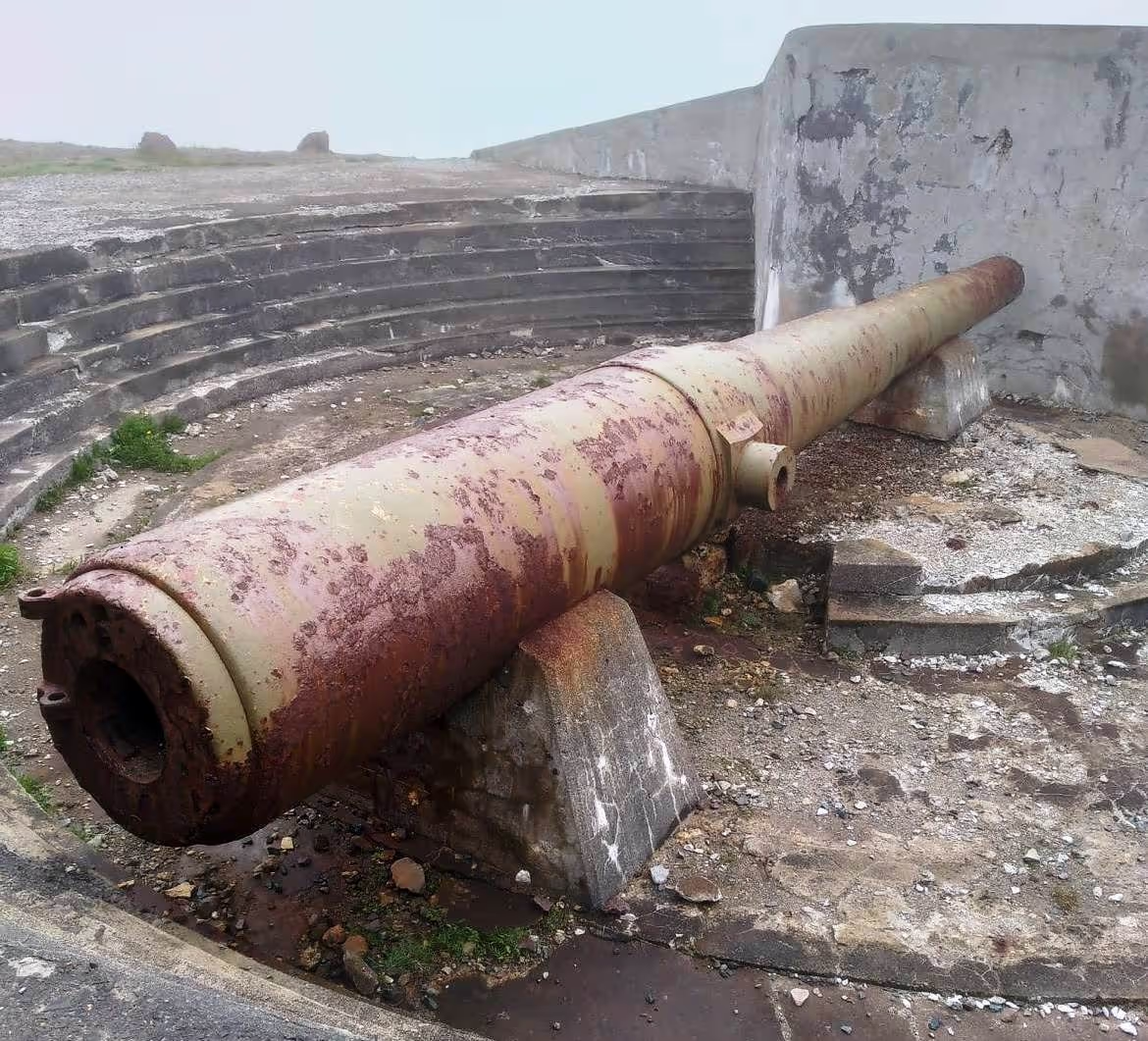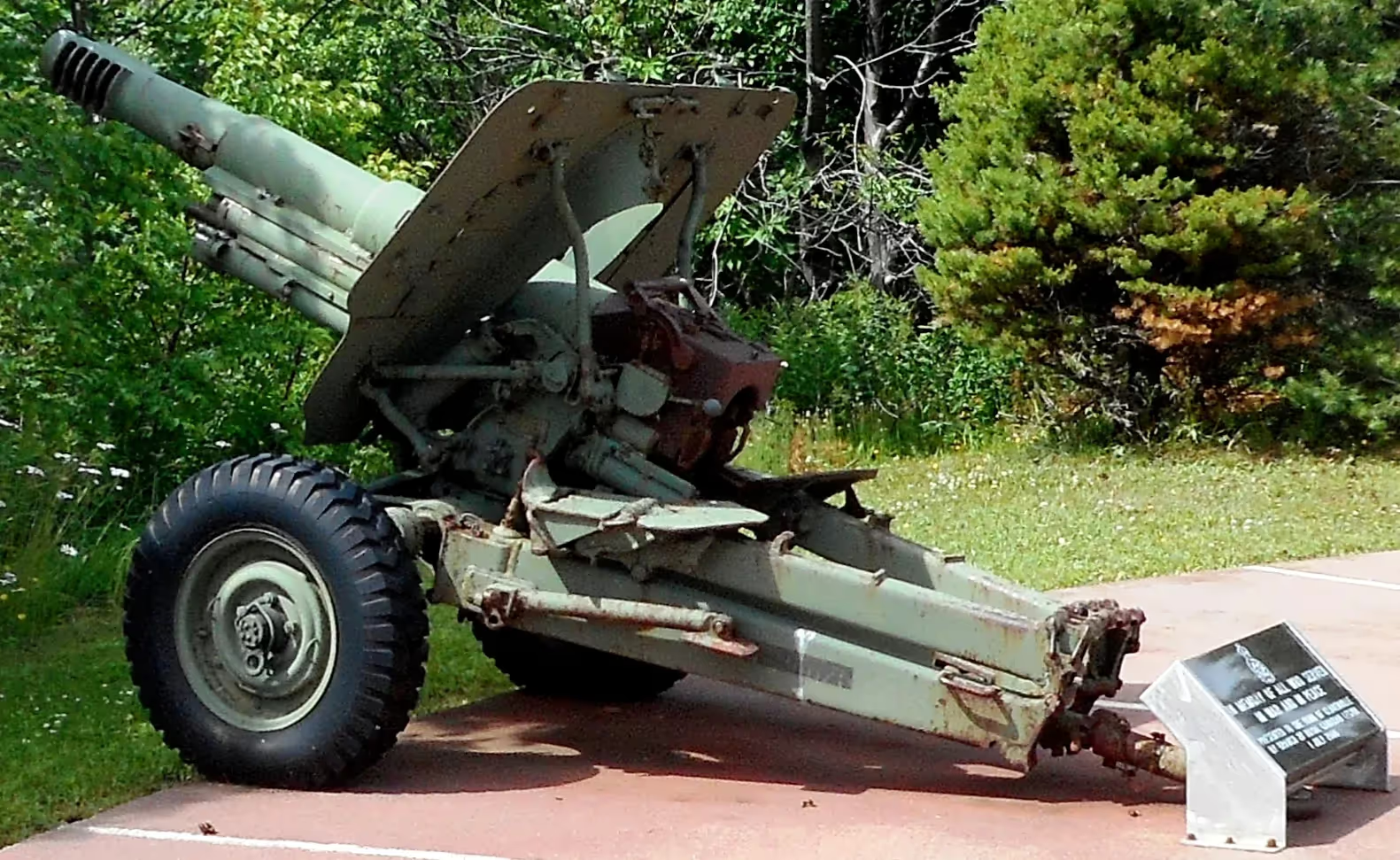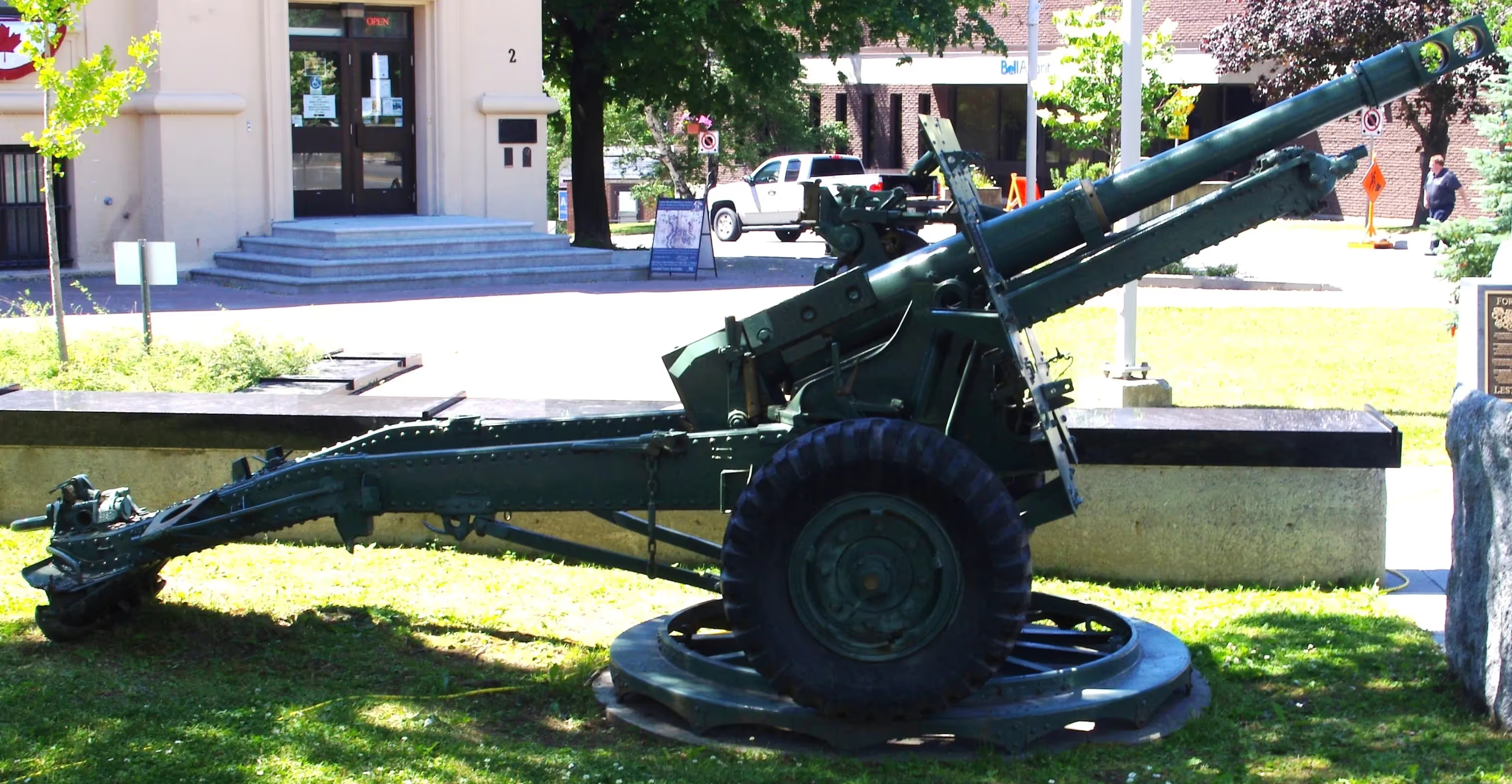Artillery in Canada (10) Newfoundland and Labrador: Cape Spear, Cape Little, Carbonear, Catalina, Centreville-Wareham-Trinity, Clarenville, Corner Brook, Cupids, Ferryland, Grand Falls-Windsor, and Greenspond
Artillery in Newfoundland & Labrador,
Cape Spear, Cape Little, Carbonear, Catalina, Centreville-Wareham-Trinity, Clarenville, Corner Brook, Cupids, Ferryland, Grand Falls-Windsor, and Greenspond
For all official data concerning the Royal Regiment of Canadian Artillery, please click on the link to their website:
Royal Regiment of Canadian Artillery Website
The aim of this website is to locate, identify and document every historical piece of artillery preserved in Canada. Many contributors have assisted in the hunt for these guns to provide and update the data found on these web pages. Photos are by the author unless otherwise credited. Any errors found here are by the author, and any additions, corrections or amendments to this list of Guns and Artillery in Canada would be most welcome and may be e-mailed to the author at [email protected].
Note: Back in the day, artillery in Canada was referred to by its radio call sign "Sheldrake". It is now referred to by its "Golf" call sign. (Acorn)
Cape Spear

(David Davies Photo)

(Martin Durocher Photo)

(Nilfanion Photo)

(WikPedant Photo)

(Author Photo, 14 Aug 2010)

(Dale Skaarup Photo, June 2023)
10-inch Gun M1888, (Serial No. 41), with the barrel mounted on a concrete stand. This gun was originally mounted on a disappearing gun mount, long since scrapped.
There were two of these American 10-inch M1888 guns mounted on M1894M1 disappearing Carriages stationed here. They were originally installed at Fort Mott, New Jersey in 1896, in a battery on the Delaware River to protect the approaches to Philadelphia. In November 1941 they were transferred and installed at Cape Spear. The two guns had a range of 7000 metres that would have allowed them to defend any attack by enemy vessels. These guns were known as "disappearing guns" because they were capable of being lowered behind a protective concrete barrier where reloading or maintenance could take place. The gun carriages and supports were dismantled and transferred elsewhere after the decommissioning of the site, but the guns themselves were left in place.
Although the guns were American, they were manned by the 103rd Coast Battery "A" troop which was part of the Royal Canadian Artillery. "B" troop was located at Fort Amherst and "C" troop at Fort Chain Rocks. American soldiers manned anti-aircraft search lights and a nearby SCR-271 radar station.
At the end of the war in 1945, the site was decommissioned. Everything that was able to be removed from the battery was removed, including the gun carriages, radar, searchlights, etc. The guns were left behind and have now been restored and painted to their original shape for historical purposes.
Located on top of the hill between Cape Spear and the small community of Blackhead, along the East Coast Trail are the remains of a "fake" gun battery also known as a dummy battery. After the Battery at Cape Spear was built during the Second World War, two fake guns were placed atop the hill surrounded by a series of rock walls. The dummy battery had two purposes; to discourage attack by making the area look more fortified than it actually was and to distract the enemy or draw their fire in the event of an attack.


(Gary Hebard Photos)
Interior of the Battery

(Gary Hebard Photo, 2020)

(Dale Skaarup Photo, 2023)
A second barrel (Serial No. 3, Watervliet) is in the same location. Because of its proximity to convoy routes during the Second World War, the gun battery was installed at Cape Spear to defend the entrance to St. John’s harbour. Barracks and underground passages leading to the bunkers were built for the use of troops stationed there.
A total of eight 10-inch American ex-pats were located on the East Coast during the Second World War, including two disappearing guns at Fort Cape Spear (both still there), two barbette guns at Botwood, Newfoundland, two barbette guns at Fort McNutt, McNutt's Island, Shelburne, Nova Scotia (both still there), one barbette and one disappearing gun at Fort Prevel, Quebec.

(Library of Congress Photo)
10-inch disappearing Gun M1895 being loaded by the 10th (K) Co., 13th Regiment, June, 1908, Fort Hamilton, Brooklyn, New York, USA.

(Library of Congress Photo, G.G. Bain 00540)
8-inch, 10-inch & 12-inch Guns on barbette carriages, ca 1898, Sandy Hook Coastal Defense Batteries, Gateway National Recreation Area, Fort Hancock, New Jersey.

(Jonathan Zander Photo)
10-inch disappearing Gun M1895, Fort Casey, Whidbey Island, Washington.

(Geoff Goodyear Photo)
Cape Little
Cast Iron 3-pounder 3-cwt Smoothbore Muzzleloading Gun, weight 3-3-6 (426 Lbs), unmounted, facing the water at the at the entrance to Voisey’s Bay, south of Nain, Labrador. The BP and Crown marking is the black powder proof mark of the Birmingham Proof House. From the proof marks book: "Final black powder proof mark for use with nitro powder. The same mark was also used for the final proofs with black powder for smoothbore muzzleloader barrels." There is no royal cipher or broad arrow mark. Possibly a Hudson’s Bay Company gun.
Carbonear
Cast Iron 12-pounder Smoothbore Muzzleloading Gun, weight unknown, mounted on an iron garrison carriage, previously in Labrador, now in front of the home of the late Fred Earl.

(Alan Cass Photo)

(Cynthia Davis Photo)

(Maxwell J. Toms Photo)
Cast Iron 18-pounder Smoothbore Muzzleloading Gun, with blown barrel, weight 39-3-1 (4,453 lbs), trunnions corroded, Royal cypher possibly King George II, heavily corroded, mounted on a wood stand, No. 1 of 2 on Harbour Rock Hill.
In 1812 Mr. H. C. Watts asked Governor Duckworth to give Carbonear three guns to protect itself from American privateers. The biggest gun was called "Watts Long Tom" and was mounted on Harbour Rock Hill. Watts' Long Tom, was placed in a gun pit at Crocker's Cove Point in 1812 by the crew of H.M.S. Comet, under the command of Capt. Blamey. He had been sent around the harbours to the north of St. John's both to place weapons to defend the harbours and to raise Volunteer Companies to man them. (Duckworth Papers pp 2647-50, 2810-2811 et al, PANL MG204 - mf copy of orig. PAC). The cannon was hauled from Crocker's Cove Point to Harbour Rock Hill in February 1817 during the Winter of the Rals. The starving men from the smaller coves to the north of Carbonear aimed it into the town to threaten the merchants into giving them supplies. They came to some resolution. It appears to be an older pattern Armstrong 18 or 24 pdr, probably from the stores in St. John's. Someone tried to fire it in recent times and blew the front of the muzzle off. (Alan Cass, Carbonear Heritage Society)

(Cynthia Davis Photo, Town of Carbonear)

(Alan Cass Photo)

(Maxwell J. Toms Photos)

(Terry Honour Photo)
Cast Iron 12-pounder Smoothbore Muzzleloading Gun, heavily corroded, mounted on a wood stand, No. 2 of 2 on Harbour Rock Hill. This gun is old and the trunnions are corroded, the cascabel is broken and numbers are not visible. It is reported to have come from the local community of Freshwater. Its owners and origins are unknown. (Alan Cass, Carbonear Heritage Society)


(Gary Kett Photos)
Cast Iron 6-pounder 22-cwt Smoothbore Muzzleloading Gun, weight 23-1-5 (2,609 lbs), King George II cypher, cast by Morgan no earlier than 1757, mounted on a 24-pounder Iron Garrison carriage. Private owner, Harold Forward. The cannon stands in front of his house on the Southside Road.
Cast Iron 12-pounder Smoothbore Muzzleloading Gun, no data available, mounted on a gun carriage, private ownership, Fred Earle Jrs., yard.

(Cynthia Davis Photo)


(Alan Cass Photos)


(Maxwell J. Toms Photos)


(Terry Honour Photos)



(James Stanton Photos)
3-pounder QF (V) (Vicker's Model) Hotchkiss Gun, mounted on a naval gun stand in the War Memorial Park. It is marked R.C.D. 1906. It was a shipboard weapon brought to Carbonear by Capt. Cyrus Taylor, and stood across the road from his house until being moved to the present site in 1980. Capt. Taylor was captain of many semi-official vessels during and after the First World War and this 3-pounder could have been taken from any one of them. For instance he commanded the ex-RN sloop Lobelia when it had been given to Newfoundland and outfitted as a Labrador passenger ship. (Carbonear Heritage Society)

(Library and Archives Canada Photo, MIKAN No. 3403179)
Canadian soldier examining a German First World War 7.58-cm leMW trench mortar as German prisoners carrying their wounded pass by him during the advance East of Arras, France, Aug 1918.


German First World War 7.58-cm leichtes Minenwerfer neuer Art, (7.58-cm leMW n.A.), (Serial Nr. unknown), Royal Canadian Legion Branch No. 23. (Alan Cass Photos)
This leMW n.A Minenwerfer was donated to the community of Carbonear in 1921 as part of the distribution of War trophies given Newfoundland by government of Great Britain. It stood in front of the Court House, later the Town Hall, on Musgrave Street. At some point it was disposed of as scrap to the current owner. He has displayed it in front of his house on White's Road for many years, minus its wheels. (JHA 1922 appdx. p.152). (Alan Cass, Carbonear Historical Society)
The 7.58 cm Minenwerfer a.A. (alter Art or old model) (7.58 cm leMW). The Germans fielded a whole series of mortars before the beginning of the First World War. Their term for them was Minenwerfer, literally mine-thrower; they were initially assigned to engineer units in their siege warfare role. By the Winter of 1916-17, they were transferred to infantry units where the leMW's light weight permitted them to accompany the foot-soldiers in the advance. In common with Rheinmetall's other Minenwerfer designs, the leMW was a rifled muzzle-loader that had hydraulic cylinders on each side of the tube to absorb the recoil forces and spring recuperators to return the tube to the firing position. It had a rectangular firing platform with limited traverse and elevation. Wheels could be added to ease transportation or it could be carried by at least six men. In 1916, a new version, designated as the n.A. or neuer Art, was fielded that included a circular firing platform, giving a turntable effect, which permitted a full 360 degree traverse. It also had a longer 16 inches (410 mm) barrel and could be used for direct fire between 0° and 27° elevation if the new 90 kg (200 lb) trail was fitted to absorb the recoil forces. In this mode it was pressed into service as an anti-tank gun.
Carbonear Island
Cast Iron 6-pounder Smoothbore Muzzleloading Gun, severely corroded, protruding from a rock pile.
Catalina
Cast Iron 2-pounder Smoothbore Muzzleloading Gun, severely corroded, set on a wood cradle near the museum.

(Joyce Sherren Photo)
German First World War 17-cm mittlerer Minenwerfer, (17-cm mMW), medium trench mortar (Serial Nr. unknown).
The 17 cm mittlerer Minenwerfer (17 cm mMW). This mortar was useful in destroying bunkers and field fortifications otherwise immune to normal artillery. It was a muzzle-loading, rifled mortar that had a standard hydro-spring recoil system. It fired 50 kilogram (110 lb) HE shells, which contained far more explosive filler than ordinary artillery shells of the same calibre. The low muzzle velocity allowed for thinner shell walls, hence more space for filler. Furthermore, the low velocity allowed for the use of explosives like Ammonium Nitrate-Carbon that were less shock-resistant than TNT, which was in short supply. This caused a large number of premature detonations that made crewing the minenwerfer riskier than normal artillery pieces. A new version of the weapon, with a longer barrel, was put into production at some point during the war. It was called the 17 cm mMW n/A (neuer Art) or new pattern, while the older model was termed the a/A (alter Art) or old pattern. In action the mMW was emplaced in a pit, after its wheels were removed, not less than 1.5 meters deep to protect it and its crew. It could be towed short distances by four men or carried by 17. Despite its extremely short range, the mMW proved to be very effective at destroying bunkers and other field fortifications. Consequently its numbers went from 116 in service when the war broke out to some 2,361 in 1918.

(Library and Archives Canada Photo, MIKAN No. 4949668)
6-pounder AT Gun being loaded by Pat Brophy on Signal Hill, 1959.

(Joyce Sherren Photo)
6-pounder 7-cwt QF Anti-Tank Gun at the war memorial.
Centreville-Wareham-Trinity
25-pounder C Mk. I QF Field Gun with No. 9 circular firing platform, beside the cenotaph.
Possible German First World War 7.92-mm Shwarzlose MG M.7/12 mounted on a tripod beside the cenotaph.
Clarenville


(Terry Honour Photos)

(Maxwell J. Toms Photo)
105-mm L5 Pack Howitzer, CFR unknown, carriage No. 57668, 1969. This gun is located on Memorial Ave and Balbo Street, in front of the cenotaph and across from the Town Hall.
Coachman’s Cove
Shipwreck with four cannon underwater 6.5 metres down. The cannon vary in length from 2.1 metres to 2.8 metres.
Conch Harbour
Wreck of French warship Marguerite, 200 tons with 20-22 cast iron Smoothbore Muzzleloading Guns, lost in action with the British in 1707. The wreck lies in Martinique Bay, which is located at the isthmus of the Conche peninsula. It is located approximately 74 metres from shore and lies in 6 metres of water. The wreck of the Marguerite was designated a Provincial Historic Site in 1977. At least 19 of the guns are visible to SCUBA divers.
Two French warships were sunk in Martinique Bay, the Marguerite and the Murinne, though only the Marguerite has been found through archaeological diving. In 1707 there were 21 French warships along this fifty-mile strip of coastline. They carried 2,000 crewmen and were armed with a total of 516 guns, to guard the fleet of 381 fishing vessels. One third of the strength of the naval units lay at anchor at Conche (two ships) or at Carrouse (four ships).
On 2 Aug 1707, Conche Harbour was subjected to a surprise attack by two large English privateers who had shortly before attacked and destroyed the outpost at Canaries and d’Aiguillettes. In that action, they had captured the vessel Duc d’Orleans and destroyed the vessel Pine. The two French warships anchored at Conche, immobilized by unfavourable winds, had no hope of escaping the attackers. They returned the enemy’s fire but were soon set on fire and abandoned. The crewmen withdrew across the narrow peninsula separating Conche from Carrouse. The four warships waiting at the latter port took them on board and put to sea immediately, fleeing the pursuit of the English convoy.
Northeast Crouse shipwreck. The remains include timbers, a large anchor, and nine cast iron smoothbore muzzleloading guns in a parallel line. Eight were measured, 5 were 2.5 metres long and the smallest was 1.9 metres long. Lead weights were also noted nearby.
Corner Brook

(Terry Honour Photo)

(Maxwell J. Toms Photo)
25-pounder C Mk. 2 QF Field Gun with No. 9 circular firing platform, located beside the cenotaph in front of City Hall at Main Street and West Street.
Cupids

(Terry Honour Photos

(Maxwell J. Toms Photo)
Cast Iron 24-pounder 50-cwt Smoothbore Gun, heavily corroded, possibly King George II cypher, mounted on an iron garrison carriage.
Ferryland


(Terry Honour Photos)
Cast Iron Smoothbore Muzzleloading Gun, heavily corroded, No. 1 of 2 on a wooden stand beside the cenotaph.


(Terry Honour Photos)
Cast Iron Smoothbore Muzzleloading Gun, heavily corroded, No. 2 of 2 on a wooden stand beside the cenotaph.

(Jim Stanton Photo)

(Jim Stanton Photo)

(Jim Stanton Photo)

(Tony Merkle Photo)
Cast Iron Smoothbore Muzzleloading Gun, heavily corroded, mounted on rocks at an old battery going out to the lighthouse. This gun has been spiked.

(Tony Merkle Photo)

(Gary Kett Photo)
Cast Iron Smoothbore Muzzleloading Gun, heavily corroded, mounted on rocks at an old battery going out to the lighthouse. This gun has been spiked (Gary Kett)

(Tony Merkle Photo)

(Gary Kett Photo)
Cast Iron Smoothbore Muzzleloading Gun, heavily corroded, mounted on a wooden stand at an old battery on the neck going out to the lighthouse.



(Jim Stanton Photos)
Smoothbore Muzzleloading Gun, heavily corroded, on private property across the harbour.
Fogo
Six Smoothbore Muzzleloading Guns were installed at Fogo in 1771 as a defence against American and French privateers. They were set up at Garrison Point on the North Side, and Wigwam Point. The cannons were activated in 1812 because of the war between US and Britain.
Grand Falls - Windsor
3-pounder QF Hotchkiss Gun, Royal Canadian Legion Branch No. 12.

(Library and Archives Canada Photo, MIKAN No. 4233445)
25-pounder C Mk. 2 QF Field Gun with No. 9 circular firing platform, with CMP FAT & limber, 2nd Division parade, ca 1945.


(Maxwell J. Toms Photos)
25-pounder C Mk. 2 QF Field Gun with No. 9 circular firing platform, a gift from the Netherlands, this gun is on display at the town War Memorial.
According to a "Report of Disposition of War Trophies to 19 February 1921 (Journal of the House of Assembly of Newfoundland)", a captured German Field Gun (likely an FK 97), (Serial Nr. unknown), was sent to Grand Falls on 31 Dec 1920. This gun may still be there, location and confirmation to be determined.
Greenspond




(Streetview Photos)
Cast Iron possible 6-pounder Smoothbore Muzzleloading Carronade, No. 1 of 4 Guns, behind the cenotaph and in front of the Greenspond Memorial Library.
Cast Iron Smoothbore Muzzleloading Gun No. 2 of 4 Guns, mounted on a concrete stand behind the cenotaph and in front of the Greenspond Memorial Library.
Possible German First World War 24-cm Flügelminenwerfer, No. 3 of 4 guns, behind the cenotaph and in front of the Greenspond Memorial Library.
Cast Iron Smoothbore Muzzleloading Gun No. 4 of 4 Guns, mounted on a concrete stand behind the cenotaph and in front of the Greenspond Memorial Library.





